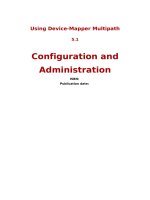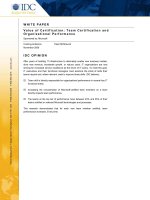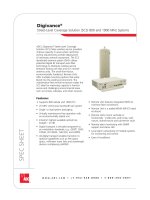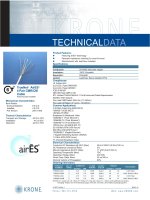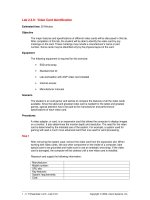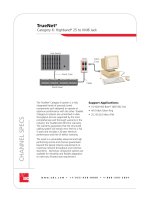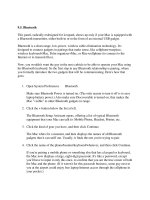Tài liệu CCIE_Train-02(2) ppt
Bạn đang xem bản rút gọn của tài liệu. Xem và tải ngay bản đầy đủ của tài liệu tại đây (103.3 KB, 20 trang )
Table of contents
Exercise 1) OSPF across frame relay 2
Exercise 2) NLSP 3
Exercise 3) EIGRP for appletalk 4
Exercise 4) BGP 5
Exercise 5) Access server with remote client 6
Exercise 6) Access server with printer 7
Exercise 7) OSPF across X.25 8
Exercise 8) IPX across X.25 9
Exercise 9) Appletalk across X.25 10
Exercise 10) IP access lists 11
Exercise 11) IPX filtering 12
Exercise 12) Flash upgrade 13
Exercise 13) Multi level user login 14
Exercise 14) Dial Backup 15
Exercise 15) Dial-on-demand routing 16
Exercise 16) RSRB and SR/TLB bridging 17
Exercise 17) Integrated routing and bridging 18
Exercise 1) OSPF across frame relay
a) Cable your routers as shown on diagram 1.
b) Configure Melbourne as a 2 port frame relay (FR) switch. Connect Brisbane
and Sydney to the FR switch via their serial 0.
Give Melbourne the following Characteristics :
a. DLCI 100 and 200 on interface serial 0
b. DLCI 101 and 201 on interface serial 1
c. Map DLCI 100 to 101
d. Map DLCI 200 to 201
e. Clock both serial interfaces at 38.4kbps
f. Use Cisco LMI signaling on serial 0
g. Use ANSI LMI signaling on serial 1
Configure Sydney and Brisbane using the following guide lines
h. Use Point-to-point subinterfaces on the FR interfaces
i. One DLCI per subinterface
c) Configure your network for IP routing using the following addressing :
Router Interface Subnet of Number of bits in subnet
Brisbane Loopback0 131.108.0.0 7
Brisbane Loopback1 137.112.0.0 8
Brisbane Loopback2 137.112.0.0 8
Brisbane serial 0.X 131.108.0.0 14
Sydney serial0. X 131.108.0.0 14
Sydney Ethernet 0 192.1.1.0 4
Sydney Loopback0 131.108.0.0 7
Canberra Ethernet 0 192.1.1.0 4
Canberra Loopback0 192.1.1.0 4
d) Configure your network for OSPF between Brisbane and Sydney. Adhere to
the following :
a. Network 137.112.0.0 resides in area 1
b. Network 131.108.0.0 resides in the backbone area
e) Configure IGRP between Sydney and Canberra.
f) Redistribute routes between OSPF and IGRP on Sydney.
g) Verify that Brisbane can ping the loopback interface on Canberra Verify that
Canberra can ping all loopback interfaces on Brisbane
h) Configure route summarization on Brisbane, so a summary route for the
137.112.0.0 network on advertised to Sydney.
i) Add a route filter to the redistribution on Sydney so that the 137.112.0.0
network on Brisbane is hidden from Canberra.
Exercise 2) NLSP
a) Configure your network for IPX, including the loopback interfaces. Generate
IPX network numbers by converting the IP subnet numbers into hexadecical
numbers.
b) Configure NLSP between Brisbane and Sydney. Use RIP/SAP between
Sydney and Caberra.
c) Turn on IPX watchlog spoofing on the FR interfaces of Sydney.
d) Configure 2 static type 4 SAP’s called NETGUN and MERRY_XMAS, on the
loopback interfaces of Brisbane.
e) Configure a SAP filter on Sydney so the NETGUN SAP is NOT passed onto
Canberra. MERRY_XMAS should continue to be advertised to Canberra.
f) Allow IPX load balancing across equal cost paths.
g) Use IPXWAN on all serial lines.
Exercise 3) FIGRP for Appletalk
a) Configure your network for IPX, excluding the loopback interfaces. Configure
one zone per network, plus one global zone that covers all networks. Use
cable ranges and zone names of your choice.
b) Configure EIGRP for Appletalk and turn off RTMP between Brisbane and
Sydney. Use RTMP between Sydney and Canberra.
c) Configure an Appletalk ‘zip-reply-filter’ on Sydney, so that the local zone
associated with one of the serial sub interfaces between Brisbane and
Sydney is not visible to Canberra.
Exercise 4) BGP
Use the resulting config from exercise 1 for this exercise
a) Turn off OSPF on Brisbane and Sydney.
b) Turn on BGP on Brisbane and Sydney as follows :
a. Brisbane belongs to autonomous system (AS) 137
b. Sydney belongs to autonomous system (AS) 192
c. Configure Sydney to advertise 192.1.1.0 to Brisbane via BGP
d. Configure Brisbane to advertise 137.112.0.0 to Sydney via BGP
c) Canberra has no route to 137.112.0.0 as it is not a BGP speaker. Fix this by
configuring Sydney to advertise a default route via IGRP. Make 131.108.0.0
the default network.
d) Verify that you can ping a 137.112.0.0 interface on Brisbane, from Canberra.
Exercise 5) Access server with remote client
Objective: Configure AUX port as a one port access server.
a) Configure the auxiliary port on Brisbane as follows:
a. Interactive mode
b. IP unnumbered
c. Exec running
d. 38400 bps. 8N1
e. Default IP address from one of the loopback interfaces.
b) Ask the instructor for a Trumpet Winsock disk if not already installed on
your PC. Startp TCPMAN. EXE. Pull down the ‘File’menu and select ‘Setup’.
Configure Trumpet to use PPP, COM1 and 38400bps.
c) Connect the PC to the AUX port using a standard console cable.
d) In Trumpet pull down the dialer menu. Select ‘Manual login’. Press enter to
get an exec prompt from the router. Now start PPP by entering the
command ‘ppp’.
e) Test your configuration by telnetting (TRMPTEL.EXE) to a router from the
PC.
Exercise 6) Access server and reverse telnet
Objective: Configure AUX port to access an asynchronous device using
reverse telnet.
a) Configure the auxiliary port on Brisbane for reverse telnet.
b) Connect the AUX port on Brisbane to the console port on Melbourne, using
a black rolled flylead.
c) Test the configuration by telnetting to TCP port 2001 on Brisbane. You
should now get the exec prompt on Melbourne
Exercise 7) OSPF across X.25
Objective: Configure OSPF across X.25, treating the X.25 could as a Non
Broadcast Multi Access(NBMA) network. As opposed to using
subinterfaces
a) Use Brisbane existing lab setup, but remove the frame relay configuration
and subinterfaces from Brisbane, Melbourne and Sydney.
b) On Brisbane and Sydney, move the IP addressing from s0.1 to s0.
c) Reconfigure Melbourne for local X.25 switching, ie. for switching X.25
packets between serial 0 and serial 1. Follow the following guidelines :
a. Clock both serial interfaces at 38.4 kbps
b. Assign interfaces serial 0 the X.121 address 123450
c. Assign interfaces serial 1 the X.121 address 123451
d. Configure the serial ports as X.25 DCE
e. Use module 128
f. Use incoming and outgoing packet size of 1024
g. Use incoming and outgoing window sizes of 127
d) Configure interface serial 0 on Brisbane and Sydney for X.25 as follows:
a. Establish the correct mapping for X.25 calls between Brisbane
and Sydney.
b. Assign Brisbane the X.121 address 123451
c. Assign Sydney the X.121 address 123450
d. Allow broadcast on the X.25 cloud
e) Configure OSPF on Brisbane and Sydney, following the same guidelines as
under the OSPF over frame relay exercise. Do not forgot the ‘ip ospf
network broadcast’ command.
f) Configure RIP on Sydney and Canberra, following the same guidelines as
with IGRP under the OSPF over frame relay exercise.
g) Verify that you can ping all Brisbane loopback interfaces from Canberra, and
vice versa.
Exercise 8) IPX across X.25
a) Configure IPX to work across the X.25 network. Remove all NLSP
configuration and use RIP/SAP throughout the network. Leave all layer 3
addresses in place.
b) Verity that you can PIX ping from Brisbane to Canberra and vice versa.
Exercise 9) Appletalk across X.25
a) Configure Appletalk to work across the X.25 network. Remove all EIGRP
configuration and use RTMP throughout the network.
b) Verify that you can Apple ping from Brisbane to Canberra and vice versa.
Exercise 10) IP access lists
Objective: Configure an IP access lists for vty sessions.
a) Configure an IP standard access list for Brisbane so that telnet is possible to
and from Canberra, but not to and from Sydney. (Sessions established
either from Brisbane console port via telnet into router Brisbane).
b) Configure an extended IP access list on Sydney that allows TCP
connections between Brisbane and Canberra, but only when they have been
initiated by Brisbane.
Exercise 11) IPX filtering
Objective: Filter out IPX packets based on destination network number
a) Verify that you can IPX ping Canberra from Brisbane.
b) Configure an IPX output access list on Sydney so that Brisbane can no
longer IPX ping Canberra’s Ethernet 0 interface. Brisbane must continue to
be able to IPX ping Canberra’s loopback interface.
Exercise 12) Flash upgrade
Objective: Upgrade the IOS in flash memory via TFTP
a) Configure Sydney as a TFTP server.
b) Copy the IOS image on Sydney to Canberra using the flash helper utility.
Exercise 13) Multi level user login
Objective : configure a router to prompt for userid/password.
a) Configure Melbourne, or any router, to prompt for a userid and password, on
both console and virtual terminal ports.
b) Configure the following users and passwords :
User Password
paul keating
john howard
Exercise 14) Dial Backup
Objective : configure simple dial backup.
a) Recable your network to watch diagram 2.
b) Do an ‘erase startup-config’ on all 4 routers.
c) Using 131.1080.0, with a / 24 mask, configure IP addressing on the following
interfaces :
Brisbane Ethernet 0
Melbourne Ethernet 0, serial 0, serial 1
Sydney Ethernet 0, serial 0, serial 1
Canberra Ethernet 0
d) Configure EIGRP on all routers.
e) Configure serial 1 on Melbourne to act as dial – backup for serial 0. Adhere
to the following.
a. enable backup link when primary has been down for 10 seconds.
b. disable backup link when primary has been recovered for 15
seconds.
c. Enable backup link when load on primary exceeds 50%
d. Disable backup link when aggregate load falls below 10%.
Exercise 15) Dial-On-Demand routing
Objective: Configure dial on demand routing using a dialer group.
a) Use your existing configuration, but remove your dial backup configuration.
b) Reconfigure serial 1 on Melbourne and Sydney for DDR, as follows:
- Use DTR dialing
- Allow any IP traffic to trigger dialing
- Drop the link after 60 seconds of idle.
- Set DTR pulse-time to 1 second.
c) Make the serial 1 interface on Melbourne and Sydney passive.
d) Configure floating static routes on Melbourne and Sydney as follows:
- provide routes for the Ethernets connected to Brisbane & Canberra.
- point them out the serial1 interface
- set the administrative distance so they kicks in when serial0 breaks.
e) Test your configuration by breaking the Melbourne-Sydney serial0 link.
You’ll need to ping across the DDR link simultaneously from both ends, in
order to have both ends raise DTR at the same time.
f) Modify your DDR configuration so that:
- Only telnet traffic triggers dialing
- CHAP authentication is used
g) Configuration the serial0 interfaces between Melbourne and Sydney for link
compression.
Exercise 16) RERB and SR/TLB bridging
a) Using the configuration from exercise 15) create a RSRB/TLB environment
between Brisbane and Canberra. Re-configure the link between Melbourne
and Sydney as virtual ring and translational bridging on the Ethernet links to
Brisbane and Canberra.
b) Enable LAT on the Ethernet interfaces of Brisbane and Canberra. Configure
Brisbane to advertise a LAT service called QLD.
c) Verify bridging functionality using “lat QLD” from Canberra to Brisbane.
Exercise 17) Integrated Routing and Bridging
Reconfigure all routers for IP/IPX addressing as follows:
Router Interface IP Network Mask IPX
Network
Brisbane e0 131.108.0.0 /24 10
Brisbane loop0 131.108.0.0 /24 11
Melbourne e0 no IP address 10
Melbourne s0 no IP address 20
Melbourne s1 131.108.0.0 /24 21
Melbourne bvi 131.108.0.0 /24
Sydney e0 no IP addres 30
Sydney s0 no IP addres 20
Sydney s1 131.108.0.0 /24 21
Sydney bvi 131.108.0.0 /24
Canberra e0 131.108.0.0 /24 30
Canberra loop0 131.108.0.0 /24 31
a) Configure Sydney and Melbourne for integrated bridging and routing. Bridge
IP packets between e0 and s0. Route IP packets between s1 and bvi.
b) Use RIP as your routing protocol.
c) Verify your configuration by telnet’ing from Brisbane to Sydney, Canberra
and Melbourne.
